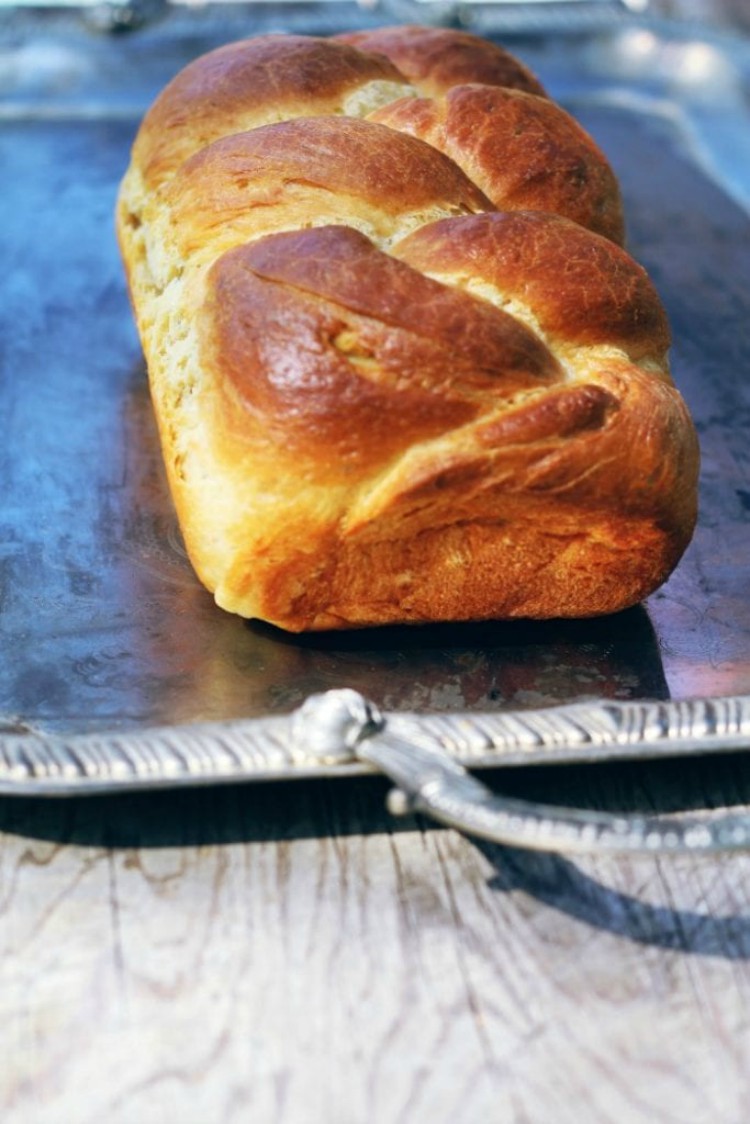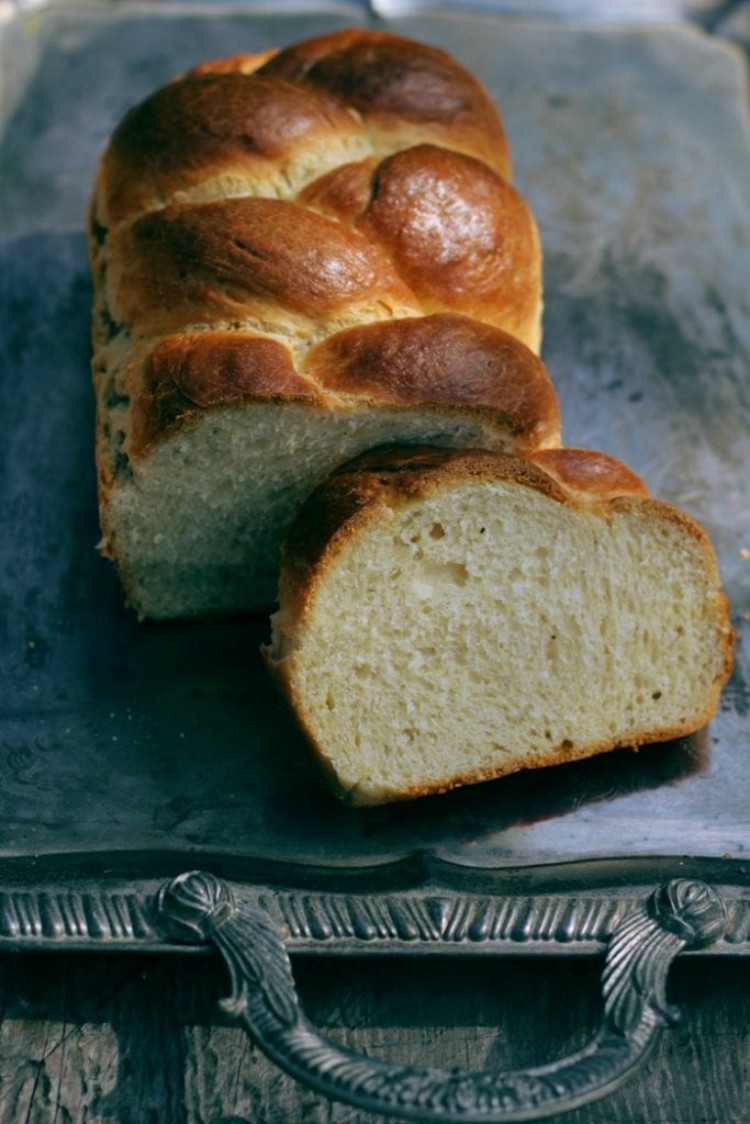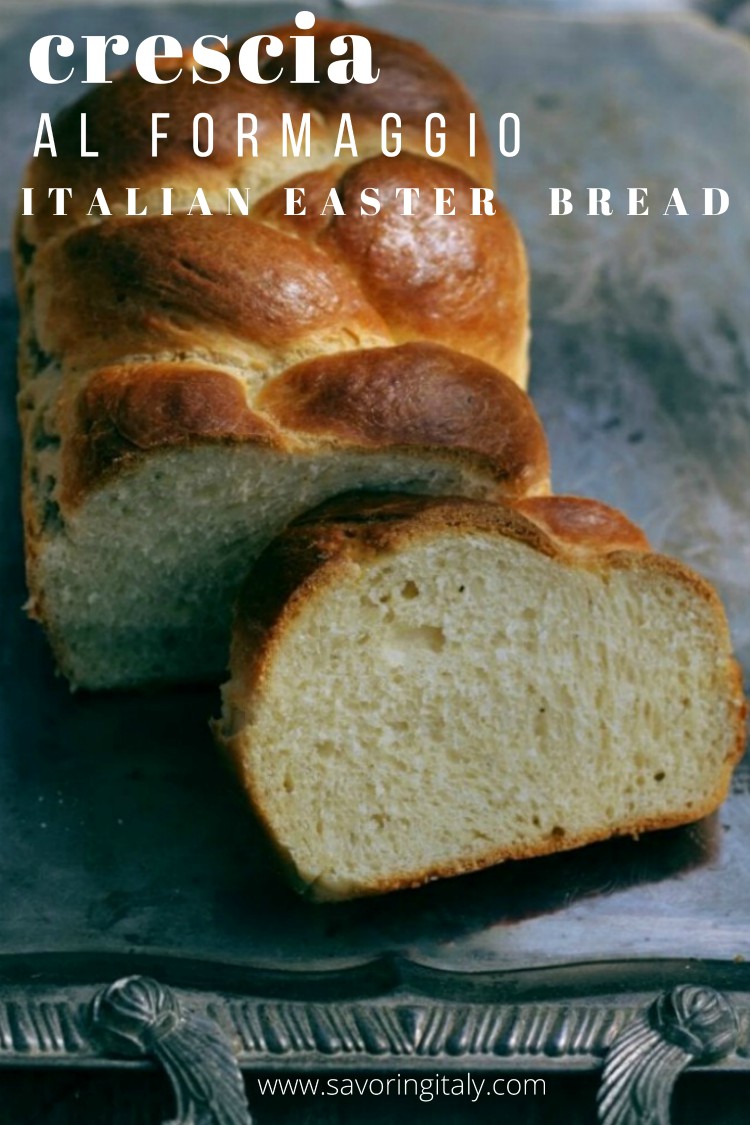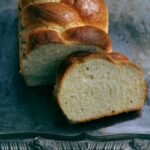Crescia al Formaggio-Italian Easter Cheese Bread is a typical Italian bread you will find in Italy. There is nothing better than the scent of a homemade bread coming out of the oven, especially one that is filled with cheese!

I'm dreaming of enjoying Pasquetta in Italy and having a slice of this crescia al formaggio -Italian Easter cheese bread. There is nothing better than the scent of a homemade bread coming out of the oven, especially one that is filled with cheese!
Jump To
- What is Crescia?
- What is Pasquetta?
- What do you eat on Pasquetta?
- What ingredients do you need for a Crescia al Formaggio
- How do you make a crescia?
- Recipe Notes
- Substitutions and Variations for Italian Easter Bread:
- What cheese is used in Crescia al Formaggio-Italian Easter Cheese Bread?
- FAQ'S
- Some Easter recipes we love:
- Crescia al Formaggio-Italian Easter Cheese Bread
What is Crescia?
Crescia is a typical bread you will find in Le Marche and also in Umbria (it is also called Pizza di Pasqua or even Crescia Brusca). You will find it either baked as thin as a focaccia or really tall (made in a panettone pan).
Originally published on March 28, 2016 and updated on March 2023.
Hi, my friends. I'm feeling nostalgic about Easter celebrations in the past and know it will be very different again for most of us this year. This is one of my favorite Italian cheese breads. I think you'll really enjoy it! Buona Pasqua to all of you!
What is Pasquetta?
You may be wondering what is Pasquetta. Easter Sunday in Italian is called Pasqua, and Pasquetta is the Monday after Easter. They say in Italy, "Natale con i tuoi, Pasqua con chi vuoi." Which means, "Christmas with your family, Easter with whomever you want.
Which should mean, there will be no Italian guilt trips if you decide on this lovely day to head off on a pic-nic with your BFF's or with your BF or your GF. So it should be totally cool to tell your mother that you are not going to be joining her for lunch.
It would have been better if her package had arrived the week before or even after Easter to just keep it simple. But I have to say, slices of salami and cheese and olives are what you eat with this gorgeous crescia!
What do you eat on Pasquetta?
Since you are going on a picnic with your friends and special people, you would be bringing a frittata, this bread, cheese, or even this casatiello. Typically a crescia is to be enjoyed on Easter. It is even baked a few days before Easter in some parts of Umbria and the local women bring their breads in baskets to the local small churches to have it blessed by the priest for Easter.

Speaking of Italian guilt trips, I got one for you. Just the other day, the long awaited care package from Teresa finally arrived. She was sort of getting anxious as the weeks passed (we were on week 3)and I told her still no package.
She told me I should go to the post office and inquire about it. And I told her I could, but I need a little info on this box. Perhaps a tracking number or something else that proves she sent the package.
Imagine our delight that the day we finally got the tracking number, the package was left at our door! Teresa sends the best care packages and most of them involve something she's made. In this package we got her latest salami that she made. Yep, Teresa is amazing!
So she tucked into the box candies, some Italian snack cakes my son loves, her olives from Calabria, and her salami. I am sure everyone gets packages like that from their mother-in-law, no?
Well, it arrived on Thursday and it had to go in the fridge to chill al little. Everyone was anxious to try it the next day. The next day, the guys were slicing it away and enjoying it with bread, her olives, chunks of cheese. At that same moment, my husband decided to call her and let his mamma know how amazing it all was. After a while, Teresa realized that they were eating meat on Good Friday.
Gasp! She said in Calabrese, "Today of all days, son! It's Good Friday!" There were some long sighs and some references to Jesus and I felt just awful, because I should have reminded him that it was Good Friday.
What ingredients do you need for a Crescia al Formaggio
- Unbleached All-Purpose Flour
- instant yeast
- sugar
- eggs
- lukewarm water
- softened butter
- salt
- ground pepper black if you don't mind the specks, white if you do
- freshly grated Parmeggiano-Reggiano Romano, or Asiago cheese, or a combination
How do you make a crescia?
The entire beautiful bread begins with the yeast! You must proof your yeast and it does take a little patience.
- add the water to the bowl of the mixer, heat it up until it's about 110F.
- stir in the sugar;
- sprinkle on yeast
- let it do its magic and proof, do not touch it while it blooms (could take 10-15 minutes)

It would have been better if her package had arrived the week before or even after Easter to just keep it simple. But I have to say, slices of salami and cheese and olives are what you eat with this gorgeous crescia!
Recipe Notes
some notes on this recipe: This dough is really easy to put together. It is a yeast dough, but fear not! It's worth taking a little time to wait for the yeast to proof and get this dough started. I love to make quick breads, but when I find the time, I will happily make a yeast bread. Trust me, I know this looks like there were no problems, and I have braided countless breads, but something threw me off in braiding this loaf.
I had my 3 sections divided, but something wasn't looking right in the loaf once it was braided. So I took the section apart and rolled them out again. I persisted until it looked right, and this dough was forgiving. The scent of this Italian cheese bread baking is absolutely heavenly! I cannot wait to bake another one this weekend!

Pin it to your EASTER, HOLIDAY, or BREAD Board to SAVE for later! Find me on Pinterest for more great recipes! I am always pinning :)!
Substitutions and Variations for Italian Easter Bread:
- Unbleached All-Purpose Flour: You can use bleached all-purpose flour or bread flour instead of unbleached all-purpose flour.
- Instant Yeast: You can use active dry yeast instead of instant yeast, but make sure to activate it in warm water before using it in the recipe.
- Sugar: You can use honey or maple syrup instead of sugar to sweeten the dough.
- Eggs: If you don't eat eggs, you can use egg replacers or flax eggs instead. To make flax eggs, mix 1 tablespoon of ground flaxseed with 3 tablespoons of water and let it sit for 5-10 minutes until it thickens.
- Lukewarm water: You can use warm milk instead of water to make the dough richer and creamier.
- Butter: If you don't eat dairy, you can use vegan butter or coconut oil instead of butter.
- Salt: You can use kosher salt or sea salt instead of table salt.
- Pepper: You can use any type of ground pepper you prefer, such as white pepper, pink pepper, or mixed peppercorns.
- Cheese: You can use any type of hard, aged cheese that you like, such as Pecorino Romano, Gouda, or Cheddar. You can also experiment with adding other types of cheese to the dough, such as feta, blue cheese, or goat cheese.
- Herbs: You can add chopped fresh herbs, such as rosemary, thyme, or sage, to the dough for added flavor.
- Spices: You can add spices, such as garlic powder, onion powder, or smoked paprika, to the dough for a savory twist.
- Nuts: You can add chopped nuts, such as walnuts or almonds, to the dough for added crunch and flavor.
What cheese is used in Crescia al Formaggio-Italian Easter Cheese Bread?
I added grated Grana Padano and also Asiago. You could add grated Parimigiano Reggiano or Pecorino Romano. You could add a combo of all of them, if you like. I liked the spicy touch of Asiago and I also added a little extra cracking of black pepper. All of the crescias I have seen are made in a panettone pan and are really high!
FAQ'S
Yes, you can make the dough ahead of time and refrigerate it overnight. Just make sure to let it come to room temperature before rolling it out.
Yes, you can freeze the dough for later use. Just wrap it tightly in plastic wrap and store it in an airtight container or freezer bag for up to 3 months.
Yes, you can use a stand mixer or a food processor with a dough hook attachment to make the dough. Just make sure to follow the manufacturer's instructions and not overwork the dough.
Yes, you can use any type of hard, aged cheese that you prefer. Just make sure to grate it finely so it mixes well with the dough.
Yes, you can use active dry yeast instead of instant yeast. Just make sure to activate it in warm water before using it in the recipe.
You can try using egg replacers or flax eggs instead of eggs. To make flax eggs, mix 1 tablespoon of ground flaxseed with 3 tablespoons of water and let it sit for 5-10 minutes until it thickens.
Yes, you can add chopped fresh herbs, such as rosemary, thyme, or sage, or spices, such as garlic powder or smoked paprika, to the dough for added flavor.
The dough needs to rise for about 1-2 hours or until it doubles in size. However, the rising time may vary depending on the temperature and humidity of your kitchen.
Some Easter recipes we love:
- Easter Spiral Ham
- Italian Easter Meat Pie-Pizza Gain
- Casatiello
- Braided Italian Easter Bread
- Torta Pasqualina
Did you make this? Please RATE THE RECIPE below:)
Please Subscribe and give a follow on Instagram, Facebook, Pinterest, and TikTok xx
Crescia al Formaggio-Italian Easter Cheese Bread
Ingredients
- 2 1/2 cups Unbleached All-Purpose Flour
- 1 1/4 teaspoons instant yeast
- 1 tsp of sugar
- 3 large eggs at room temperature
- 1 large egg yolk white reserved
- 1/4 cup lukewarm water
- 1/4 cup 4 tablespoons softened butter
- 1 teaspoon salt
- 1 teaspoon ground pepper black if you don't mind the specks, white if you do
- 1 1/4 cups freshly grated Parmeggiano-Reggiano Romano, or Asiago cheese, or a combination
Instructions
- In a mixer, with a dough hook attachment, add the warm water (110F), yeast, and a teaspoon of the sugar. Mix until blended. In about 10-15 minutes the yeast will proof. In a small bowl, combine the flour, salt, pepper and cheese.
- Slowly mix in 1 cup of the flour mixture into the bowl with the activated yeast until combined. Mix in the eggs one at a time until they are combined. Add another 2 cups of the flour mixture, butter and salt. Mix together on medium-low speed stopping the machine to scrape down the sides of the bowl. Slowly add the rest of the flour and mix until combined. Stop the machine as you add each cup of the flour to scrape the sides of the bowl and incorporate the flour.
- Mix on low speed for 10 minutes until dough is incorporated. Be sure to give your mixer a break, as you don’t want to burn it out.
- Add flour if needed 1 tablespoon at a time. The dough will be a little sticky but also firm.
- Take dough out of mixer bowl, form into a ball and coat with a light film of canola oil (or whatever oil you prefer).
- Form the dough into a ball and place into an oiled bowl (when I put the dough in the bowl I swish the dough around the bottom of the bowl and then flip it over so all of the dough is covered in a light film of oil). Cover with plastic wrap and let it rise at room temperature until doubled in size (about 1-1 1/2 hours).
- Oil or flour your hands. To make a traditional round loaf, form the dough into a ball, and place it in a greased pandoro (star) or panettone pan; a large souffle dish; or another round, deep pan. The pan should be about 6" to 7" wide, and 3" to 4" deep.
- To make a pretty loaf, divide the dough into three pieces; roll each piece into a 12" log; and braid the logs. Nestle the braid into a lightly greased 9" x 5" loaf pan.
- Cover the loaf lightly, and allow it to rise for 1 hour (or longer, depending on the warmth of your kitchen, my loaf was ready to bake in one hour); the dough should have become noticeably puffy, though it won't have doubled in size.
- To bake the bread: Put your oven rack in a lower position, just below the middle, and preheat the oven to 350°F.
- Bake for 35-40 minutes, until it's a deep, golden brown and an instant-read thermometer inserted into the center registers 190°F. The braided loaf will require less time than the round loaf.
- Remove the bread from the oven, and let it cool in the pan for 5 minutes. Use a knife to loosen the edges, if necessary, and turn the loaf out onto a rack to cool completely before slicing.
- Store airtight, at room temperature, for several days. Freeze, tightly wrapped, for longer storage.
Nutrition Disclaimer
Please keep in mind that the nutritional information presented below is an approximation and may vary depending on the exact ingredients used.




Angela says
The directions call for sugar but sugar isn't shown in the ingredient list. I haven't seen sugar in any recipe for this bread, so I'm curious.
Savoring Italy says
Hi Angela, the sugar was to activate the yeast. 🙂
mimi rippee says
Oh, this is nice. I like that it's savory - I'd much rather have anything savory than a sweet treat. Funny story about good friday!
Lora says
I also love savory breads!! Happy Easter, Mimi!
rebecca says
looks wonderful 🙂
Lora says
Hi Rebecca-thank you! XX
Anne says
We really enjoyed this cheese bread. The dough is easy to make! Making again this year for Easter. Give it 5 stars!
Lora says
Hi Anne-so happy you love the crescia and that you'll make it again this year. Thank you for the kind comment!XX